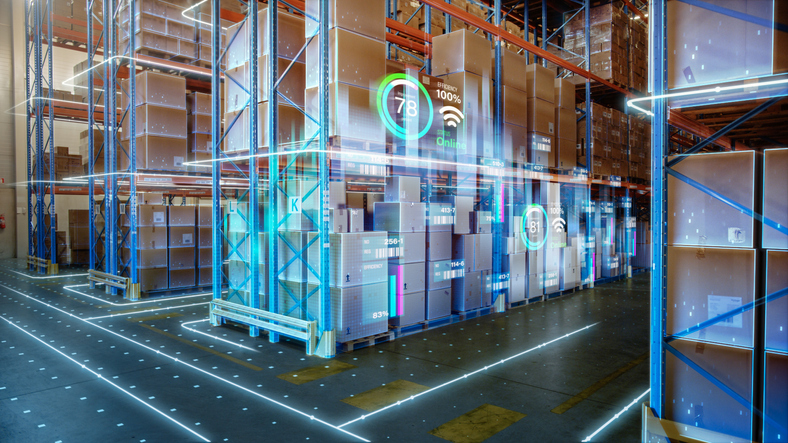 Smart homes. Smartphones. Smart…warehouses? In a time when the term “smart” is bolted onto nearly every aspect of our lives, it can be difficult to pin down what this ubiquitous term actually means. As TFS knows from experience, however, accelerating or enhancing warehouse operations rarely begins with flicking a switch.
Smart homes. Smartphones. Smart…warehouses? In a time when the term “smart” is bolted onto nearly every aspect of our lives, it can be difficult to pin down what this ubiquitous term actually means. As TFS knows from experience, however, accelerating or enhancing warehouse operations rarely begins with flicking a switch.
“It’s easy for companies to get overwhelmed with the term ‘smart’ because it can mean so many things to different companies,” says Ryan Boyd, Vice President, Storage and Automation with TFS. “But as we often find when working with clients, truly ‘smarter’ warehouses begin with making simple but effective changes even before you bring new technology through the door.”
What does smart mean to you?
For many, the buzzword has come to mean anything that has been upgraded with automation, artificial intelligence (AI), or other shiny new technologies to be “smarter.” And while this definition certainly holds, there are often easier and more cost-effective ways to achieve the same productivity and efficiency upgrades before adding tech to the equation.
“A lot of people approach the idea of becoming a smarter warehouse by buying technology, even before they’ve really thought through what they’re trying to accomplish,” said Scott Carlin, Chief Sourcing Officer at TFS. “The first thing we do when a client says they want a ‘smarter’ warehouse is to take a step back and say, ‘Let’s evaluate where you are, where you want to go and find ways to work smarter before making a huge investment.”
For example, adopting a more efficient warehouse layout may be the smartest first move a client can take. Another possibility, depending on a facility’s needs, could be implementing more effective racking that maximizes the warehouse footprint. And, of course, there are many small changes that would result in more sustainable and cost-friendly fleet management.
“Everyone has a different definition of what ‘smart’ means for their operations. Before we go looking for a tech solution to solve their problems, it always pays to look at what can be done at the moment, before making an investment,” Carlin added.
The foundation for “smarter” warehouses
The solution to becoming a ‘smarter’ warehouse may very well be to invest in an automation journey. Even if this is the case, there is upfront work to be done to ensure those investments deliver value to the company.
“You may have the option to replace a human with a piece of software or automate a critical task to save time, but first, you have to optimize the processes around those functions before you can start thinking about becoming a smart warehouse,” insists Boyd. “That means going into those individual departments, looking at those specific functions you want to make ‘smarter,’ and optimizing the processes around those functions so that they’re repeatable and the most effective they can be.”
Indeed, automating an inefficient process or throwing tech at an unoptimized function won’t produce the desired result, let alone make the best use of one’s investment. To start, it pays to streamline and standardize your processes, laying the most effective foundation for automation.
“If you’re not creating standardized work, then you have no chance of creating any type of improvement to those processes—let alone ensuring associates are doing the same things in the same way to maximize efficiencies,” says Boyd. “It’s so important to create that standardization and document those everyday steps so that we can come in, evaluate those steps and say, ‘Here’s how now we can optimize that process even further and make it even smarter.'”
Simplifying the automation journey
There are no cookie-cutter solutions to creating a smart warehouse. And when it comes to bringing automated systems to material handling operations, TFS believes in making the journey as streamlined and custom as possible.
For the TFS team, that involves determining how their customers define “smart,” assessing their current state, and applying all the non-tech solutions first. Then, it means narrowing in on the automated solutions that fit the customer’s needs.
“And that means something different for every facility,” adds Carlin. “Our approach is to not sell what is convenient to us rather what is right for the customer, whereas we know those investments only work if we’re partnering with the client to determine what will truly benefit their people and their environment.”
Intelligence in stages
If and when an automated solution makes sense, the next step is to take a measured and calculated approach to implementation. For TFS, it’s a process that includes reviewing potential systems that meet the client’s requirements, sourcing equipment that matches those exact needs, and then designing and executing an implementation plan that ensures all stakeholders are on board.
After that, says Boyd, it’s about implementing tech solutions in calculated steps: “It may be a case of saying, ‘Let’s start small and do these types of solutions first. Then, after we get proof they work, let’s move on to another part of the warehouse where we can make an even bigger impact. By picking off the low-hanging fruit first, you start to get buy-in from all stakeholders, which is what you’re going to need if you want success on larger projects. ”
Becoming smarter doesn’t stop with implementation, either. Extracting full ROI from a new piece of technology or smarter process requires a commitment to continuous monitoring and improvement.
“Again, it’s a journey,” added Carlin. “That’s why it’s so important for us to really dig in as the customer’s partner and become part of their team. That way, we can understand what’s going on in their four walls and help them become ‘smarter’ in a way that makes the most sense for them.”

